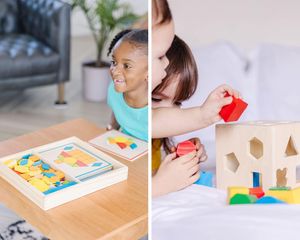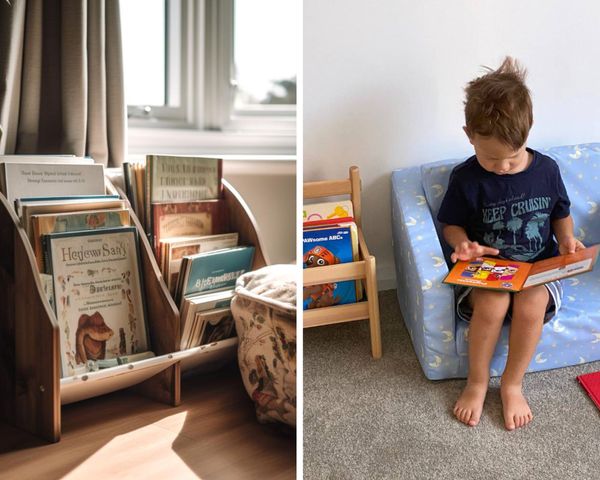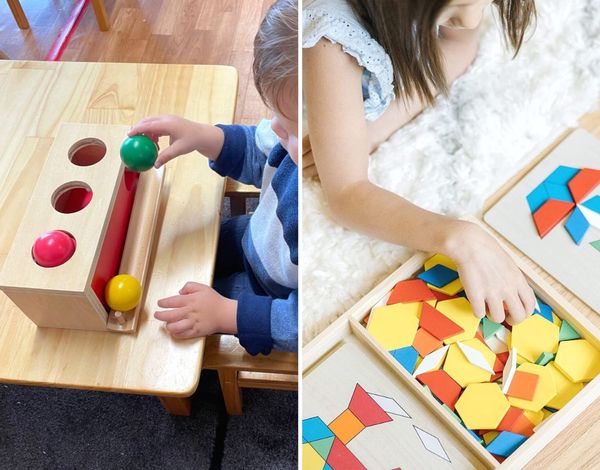Do you wish there was a way to encourage your child's independence and self-exploration even in their sleep?
I think I've got the perfect solution for you. It's time to dive into the transformative world of Montessori beds. These unique, low-level beds are more than just a piece of furniture. They're a tool for nurturing your child's natural growth, curiosity, and most importantly, their independence.

In this comprehensive guide, we will be covering:
- The intriguing origins of Montessori beds.
- Different types of Montessori beds: Floor Beds and House Beds.
- The key principles and advantages of using a Montessori bed.
- Essential design features and recommendations for your choice of Montessori bed.
- How to choose the right Montessori bed, with an emphasis on safety considerations and transitioning from a crib.
- The range of sizes and styles available for different needs.
- How to set up a Montessori-inspired bedroom.
Every child's journey is unique, and here at The Montessori Compass, we believe in supporting that individual journey by helping you discover your child's true north. A Montessori bed isn't just a bed—it's a step toward a more independent and self-reliant child, fostering a strong sense of self and love for learning.
Let's start this journey together.
Origins of Montessori Beds
As I researched the origins of Montessori beds, I learned that they are deeply rooted in the Montessori method, developed by Dr. Maria Montessori in the early 1900s. Dr. Montessori, an Italian physician and educator, is the person behind the Montessori philosophy, which focuses on promoting child-led learning through independence, exploration and self-direction.
A central tenet of the Montessori method is the idea of free access, meaning that children should be able to move freely within their environment and engage with the materials that interest them. Maintaining a low and unobstructed layout in the learning environment is crucial so that young children can navigate their surroundings with ease.

In line with this philosophy, Montessori floor beds are designed to be low to the ground, ensuring that children can enter and exit the bed without adult assistance. The Montessori floor bed, often referred to as a floor bed, allows young children the autonomy and independence they need for their development, which is in cintrast to what is normally used as toddler beds.
This approach encourages children to assert ownership over their environment and develop a sense of agency and confidence, and by fostering independence and freedom of movement, these floor beds provide a safe and empowering space for a child's growth and development.
Types of Montessori Beds
Floor Beds
I have been using the terms somewhat interchangeably, but there is a subtle difference between the two popular versions.
The Montessori floor beds are quite popular among parents who want to follow the Montessori method for their children's early years. A floor bed is simply a bed or mattress (usually a crib mattress, but you can also use a twin size mattress for more than one child) placed on the floor without any additional frame or support. This low-to-the-ground design enables young children to enter and exit their bed easily and promotes independence and self-sufficiency.

There are various Montessori floor bed options available in the market. Some are just a mattress on the floor, while there are others, like the 5 Little Monkeys Sleep System, which come complete with a pillow and mattress protector. The choice depends on the parents' preferences and budget.
House Beds
Another popular option in Montessori beds is the house bed. House beds have a frame that resembles a house, with a low-to-the-ground mattress. The concept of house beds is to provide children with a sense of security and a fun, engaging space where they can feel at home.
One of the popular Montessori house bed options is the Camden House Bed by Pottery Barn Kids. This classic house-shaped bed accommodates a twin or full-sized mattress and offers a more polished slightly raised bed look compared to a simple mattress on the floor.

Montessori beds come in two main types: floor beds and house beds. Floor beds are simple and low-to-the-ground, promoting independence, while house beds offer an engaging and secure environment for children. Take into account your own preference and that of your child before deciding which one best fits your family’s needs. There is also the aesthetic to consider of course (that’s my wife’s voice coming through)
Key Principles and Benefits
Independence
One of the primary reasons parents choose a Montessori bed for their children is to promote independence. Unlike traditional cribs, these beds allow young children to easily enter and exit without adult assistance, giving them a sense of autonomy in their sleeping environment.
Freedom of Movement
Montessori beds facilitate freedom of movement, supporting child development by letting them follow their natural instincts to explore and move around. This is a crucial aspect of the Montessori philosophy, which aims to help children learn through self-exploration.
Safety
Since Montessori beds are low to the ground, the risk of injury from falls is reduced. This design aspect provides peace of mind for parents, as they know their child is safer during sleep and while navigating their room.

Confidence and Ownership
A Montessori bed encourages children to take ownership of their sleep environment. This fosters confidence and responsibility, as they begin to understand their own needs related to sleep and bedtime.
Education and Respect
The Montessori philosophy emphasizes education and respect for the child's individual pace of learning. By using a Montessori bed, parents respect the child's autonomy and allow them to develop their own sleep routine, which is an essential life skill.
Exploration and Autonomy
As children grow and develop, they naturally become more curious and eager to explore. A Montessori bed encourages this behavior by offering an environment that is easily navigable and tailored to their needs. This promotes autonomy and helps them develop essential skills for self-reliance and self-discovery.
Design Features and Recommendations
Now, in our journey of introducing the Montessori bed to our eldest as his very own toddler bed, I was initially unsure about the best approach to adopt. But after some thorough research, trial and error, speaking to a few experts and observing Christian and his behaviours, I've gathered some key insights to share with you all that will hopefully save you some time in your journey:
- Accessibility and Independence: Montessori beds are low to the ground for easy access, promoting independence as children can enter and exit without help.
- Bed Choices: Options range from a simple floor bed (a mattress directly on the floor, which is what we went with initially to some success actually) to slightly elevated bed frames. A popular choice among many parents is the house-shaped bed that encourages imagination and personalizes the child's space. Have a read of this article from HuffPost for some ideas.
- Sustainable Materials: Consider natural materials like solid wood frames for sturdiness, durability, and sustainability. In my experience, natural materials are always a good choice for a Montessori bed and you can’t go wrong
- Mattress Selection: Remember to choose a mattress with the right thickness and comfort level for your child. A lower profile mattress is often easier for young children to navigate.
- Room Setup: Enhance your child's independence by adding low shelves with age-appropriate toys and books, installing low hooks for clothes, and using child-sized furniture.
- Safety Measures: While Montessori beds typically lack rails, placing a soft floor mat or a low couch next to the bed can provide extra security and prevent falls during sleep. Also, and this point may be a bit controversial amongst the community, but I would recommend waiting until your child is at least 2 years old before introducing them to a Montessori bed, like we did. Read the safety section below for further thoughts on this.

With these principles in mind, you can create a Montessori-inspired bedroom that fosters creativity, self-discovery, and independence for your children, helping them thrive in a nurturing and supportive environment.
Choosing the Right Montessori Bed For Your Kids
Safety Considerations
Given the nature of them, you might be asking yourself: are Montessori floor beds safe? As we've already touched on in the previous section, when choosing a Montessori bed, safety should be the top priority. I always look for beds that are low to the ground, making it easy for young children to enter and exit without adult assistance. This lowers the risk of accidents and helps build their confidence. It's also important to ensure that the child's bedroom is safe and childproofed, removing any hazards or sharp objects that can harm them.
I follow the guidelines suggested by the American Academy of Pediatrics for avoiding SIDS (Sudden Infant Death Syndrome). While Montessori beds are not recommended for infants, it's essential to remember that once a child is old enough and can safely transition from a bassinet or crib, a floor bed is a suitable option.
I suggest waiting until your child is two years old before considering using the floor bed philosophy. Some in the Montessori community use it for infants, but it is important to digest all the information before making a decision. If you do choose to use it for a younger child, make sure the room is set up safely and age-appropriate, and that the child cannot access any unsafe areas.

Transitioning from a Crib
Moving from a crib to a Montessori bed can be a big change for children. To make the transition smoother, we started by placing the new bed next to the crib, allowing Christian to get familiar with it. Once he showed interest and confidence in exploring the new bed, we gradually removed the crib from his room. This approach helps children feel secure and in control of their sleep environment, and it definitely made the transition easier for us and for him.
Size and Styles
Montessori beds come in various sizes and styles, catering to different ages and bedroom themes. We have discussed some popular options already, but I’m just going to repeat them again for your benefit:
- House beds: These are designed like a house frame, offering a cozy and inviting space for children. It also allows room for creativity, as I can decorate the frame with lights, curtains, or other decorations.
- Simple floor bed frames: For a minimalist approach, the no-frills floor bed frame that fits around the child's mattress, sitting directly on the floor. To convert it into a platform bed, you can simply flip the bed frame upside down when you're no longer using it as a floor bed.
- Simple mattress: our favourite and a budget-friendly option. Not to mention, highly flexible in terms of moving it around. Decorate with some colourful linen and surround with shelves to really give it life and show your child you’re not just dumping them on some plain mattress.

Montessori-Inspired Bedroom Setup
If you already have the Montessori-style bed or have decided to get one, let's discuss how to create an environment that supports your child's independence and curiosity during bedtime routine. Remember that each element has a purpose and can bring fun moments as well. However, it is also important to find balance and include what you love in your design choices. For instance, if you would like to add some color to the neutral decor, like in our sample pictures, feel free to do so! It is not necessary to follow the philosophy strictly - each person has their own true north!
Here are some ideas for you to think through:
- Furniture at their level: Imagine being in a world where everything towers over you. It's quite daunting, right? That's how our little ones feel. So, in my child's room, I incorporated low shelves, tables, and chairs. It created an inviting, age-appropriate environment that really says to them, "This is your space. You run the show here!"
- Calm ambiance: A Montessori space, in essence, is a little Zen sanctuary for the kids. I aim for a serene atmosphere with mostly neutral colors and minimal decor. It's just as soothing for us adults - a win-win, I'd say! But like I said, if you’re a colors person, throw some in! Be brave.
- Safety first: I cannot stress this enough - sleep safety is paramount. With our kids having free access to their beds, it's vital to make the room a safe haven. So, cover those electrical outlets, secure furniture to the walls, install a baby gate, and keep the sleep surface firm and well-ventilated, sans any soft bedding or fluffy companions.
- DIY ventures: Work with what you have around the house! If you're a DIY enthusiast like me, here's a teaser - in one of my upcoming articles, I'll walk you through how to build a custom support frame for your child's floor bed. Exciting, right? So, stay tuned! (side topic: I actually love this because I get to dabble into DIY projects and I can now comfort my wife by telling her that it's for my blog! Now, she tells me she reads my blog, so this is a little test to see if she actually does hehe)

The objective of setting up a Montessori-inspired bedroom is to foster an environment that is safe, independent, and centered around your child. These pointers are your stepping stones towards creating a room that strengthens your child's self-confidence, ignites their inquisitiveness, and promotes a healthy sleep routine. Remember, it's about enjoying the journey, cherishing the little victories, and having a good laugh during those surprise midnight adventures.
Our Closing Thoughts
Embracing the Montessori philosophy in your child's bedroom can be an empowering and fulfilling journey. As we have explored in this article, the Montessori bed is a unique tool for fostering independence, self-discovery, and confidence in a child. It's not just about a unique bed design; it's about nurturing a child's natural growth and curiosity.
Remember the key principles we've discussed:
- Independence: Montessori beds allow your child to navigate their sleep environment freely.
- Freedom of movement: This approach supports child development by allowing natural exploration.
- Safety: The low-to-the-ground design reduces risks and ensures a safe sleep environment. Ensure you have considered the safety of the surrounding environment and the age of your child as well
- Confidence and ownership: By managing their own sleep space, children learn responsibility and gain self-confidence.
- Education and respect: Respecting a child's individual learning pace is crucial in the Montessori philosophy.
- Exploration and autonomy: Montessori beds support children's natural curiosity and desire for self-reliance.
The Montessori bed is a cornerstone in an environment that promotes learning, self-reliance, and a strong sense of self. But remember, it doesn't stop at the bed. Creating a Montessori-inspired bedroom involves incorporating low, accessible furniture, maintaining a calm ambiance, and prioritizing safety.

For those of you who enjoy getting hands-on, keep an eye out for my upcoming article where I'll guide you through building a custom support frame for your Montessori bed. It's going to be an exciting DIY project you won't want to miss!
And to supplement that, we're going to cover the best Montessori floor beds out there on the internet so there is no shortage of options we're going to make available for you.
I hope this article has provided some useful insights for your own Montessori journey. Please explore the rest of the site for more insights and remember - the Montessori approach isn't a strict set of rules but a philosophy to inspire a love of learning and independence in our children. Happy exploring!







